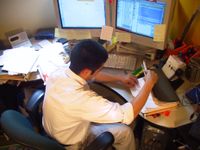 Though you can’t fully judge a person’s quality of work by glancing at their work area, most people can make an assumption.
Though you can’t fully judge a person’s quality of work by glancing at their work area, most people can make an assumption.
There is a preconception that organization equals efficiency. When you see a clean workspace, you can’t help but think that the worker is productive and gets their work done.
On the other hand, disorganization can produce a greater negative impact than the positivity of tidiness. Even if your desk is inadvertently messy, a cluttered workspace can make others think that you’re lazy, stressed, disorganized, and maybe even irresponsible. If it’s perceived that you can’t function in an organized environment or keep your workspace organized, chances are you will also be viewed as incompetent to some degree – reducing your chances of career advancement.
Avoid giving off a negative impression and jeopardizing opportunities for a promotion by keeping a messy work station. Tune into our upcoming blog about how to clean up your workspace and keep it that way.




